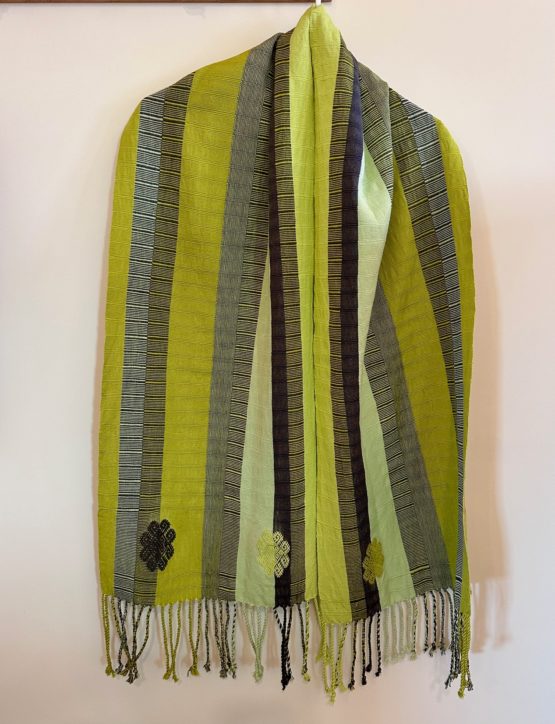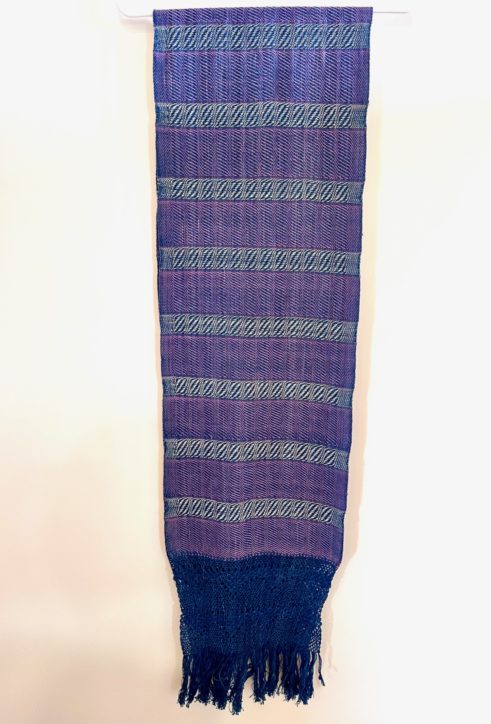The third and last day of the three-day Oaxaca Natural Dye Workshop brings together all the preparation of the first two days in a culminating extravaganza of rich, deep color.
The movement toward using natural dyes is taking hold around the world. It is an environmentally healthy process that is non-toxic and sustainable. Here in Oaxaca more weavers are using natural dyes for their beauty and because it’s what eco-minded textile lovers want.
On this last day, we prepare the indigo dye bath to color cotton and wool blue. We also use the indigo for overdyeing. This gives us a rainbow of colors.
Elsa shows the film about the small village on the southern coast of Oaxaca, Santiago Niltepec, where two families remain who preserve the ancient tradition of growing the indigo plant and making it into dye material. All the indigo that Elsa uses is native to Oaxaca.
Cochineal gives us red, orange purple and pink depending on the color of the wool, the number of dips in the dye bath, and whether we use an acid or base to modify the color.
When cochineal is overdyed with indigo, the wool becomes deep purple or lavender or mauve, depending on the strength of the dye bath and the natural wool color.

My project, making a shibori cotton textile — sewing into cloth for dye resist

Another sample: mahogany with an overdye of ferrous oxide
And a memorable learning experience that is both rewarding and fun.
Oaxaca Natural Dye Workshops from Oaxaca Cultural Navigator













































Khadi Oaxaca Clothing Now Comes in Yardage, Too
Khadi Oaxaca makes hand-spun organic cotton. Over 100 indigenous women participate in this cooperative located in the Oaxaca mountains halfway between the Oaxaca city and the coast. It takes about three hours to get there.
Dress with rolled sleeves and patch pockets.
At the winter Museo Textil de Oaxaca expoventa (show and sale), Khadi Oaxaca presented an extensive selection of beautiful clothing — mostly ponchos, quechquemitls, huipils and men’s shirts. Some of the textiles are woven on the back strap loom and others on the counterbalance pedal loom also called a flying shuttle loom.
There was lots to choose from, including bolts of beautiful handwoven material. The cotton is dyed with indigo, pericone (wild marigold) and Khadi Oaxaca also harvests and spins coyuchi, a caramel-colored, very soft wild cotton indigenous to Oaxaca and becoming very rare.
Khadi Oaxaca fabric close up, with neckline detail. Organic handspun cotton: indigo, coyuchi, pericone.
I was beside myself and had this urge to sew up a dress using a paper pattern I made from a favorite dress. I have made this dress design several times and the Khadi Oaxaca yardage was calling me. Especially the piece woven with coyuchi, indigo and pericone.
Yardage? Not exactly.
We are in Mexico and fabric length is measured in meters, not yards. We measured the dress I was wearing (one of the favorites) and decided I needed four meters, compensating for the fact that the cloth is 15-1/4″ wide. There are 0.914 meters to the yard or 1.093 yards to the meter. Never mind that after cutting out the pattern, I was substantially short! Could I make this dress sleeveless? I think not.
The Museo Textile de Oaxaca has Khadi Oaxaca textile lengths for sale. When I sent a message to Khadi Oaxaca, they told me they would bring the meters I needed to museum! Thank you and hallelujah for great customer service. Price: 350 pesos per meter.
Patch pockets. French seams! Love the slubs and irregularities of the weave.
After the intensity of our Oaxaca Women’s Creative Writing and Yoga Retreat last week that I fully participated in, writing about mother, father, family and home, I loved the down-time that this project gave me. I’ll be writing about the retreat in days to come.
Like this:
8 Comments
Posted in Cultural Commentary, Oaxaca Mexico art and culture, Textiles, Tapestries & Weaving, Travel & Tourism
Tagged cotton, coyuchi, dress design, fabric, indigo, Khadi Oaxaca, Mexico, Oaxaca, pericone, Sewing, textiles, wild marigold, yardage